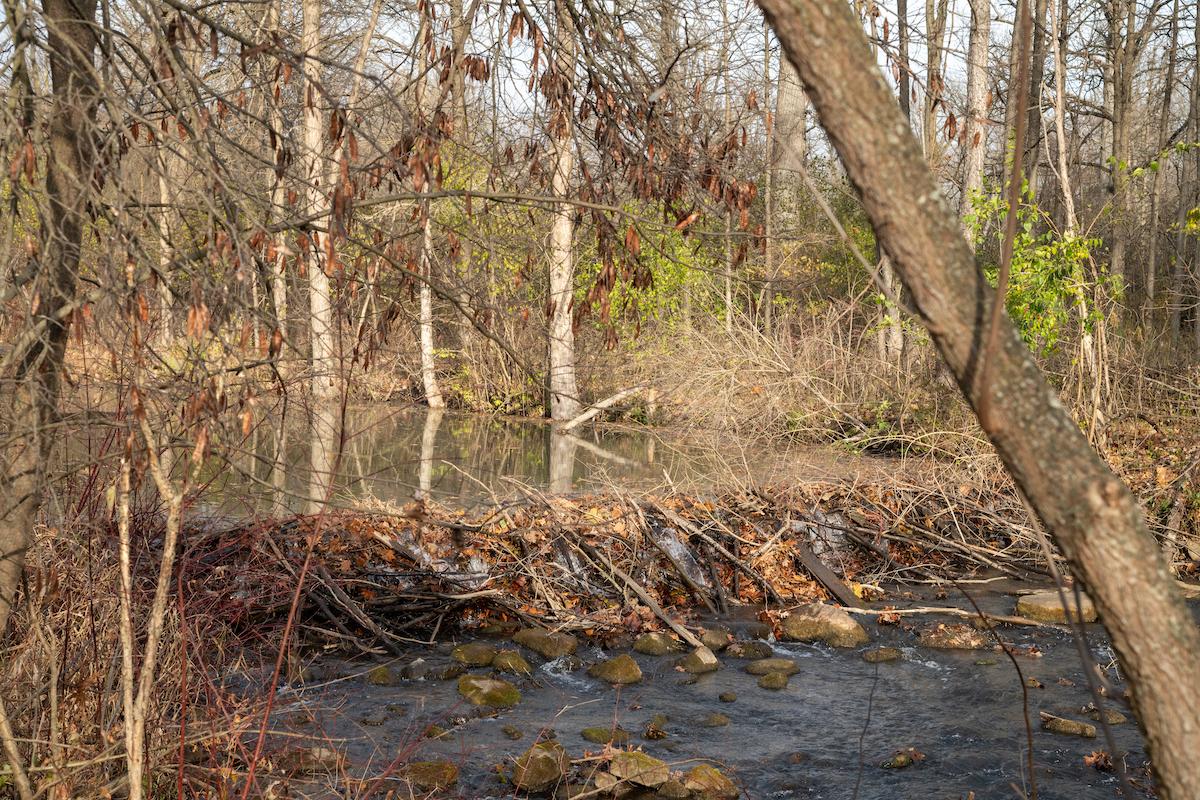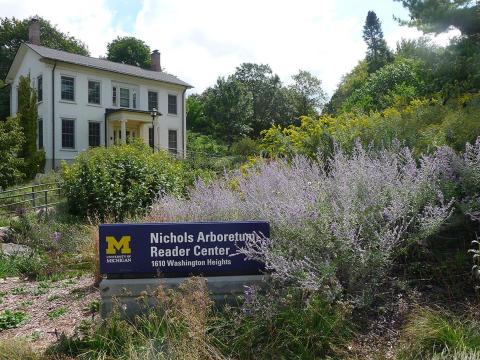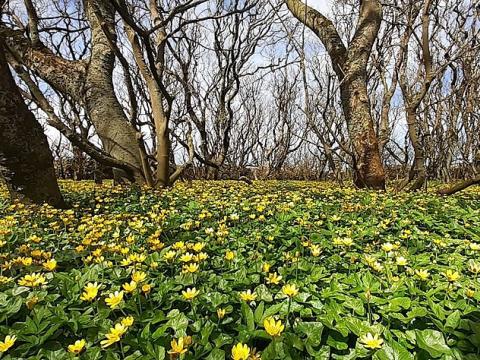
Beaver Dam John Metzler
For the first time since the gardens were founded in 1907, beavers have made a home at Matthaei Botanical Gardens. Their dam and lodge can be seen from a trail near the Fleming Creek Overlook.
“I first noticed the signs during a staff walking event on November 1st,” said Jeff Plakke, MBGNA’s Natural Areas Program Lead. “It looked like a bit of a dam had been built, but at first I was in disbelief. I thought it might have just been leaves and sticks that had fallen during a storm.”
There was no denying the other signs of beaver that were evident upon further inspection. Some trees had been stripped of bark near the base of their trunks. Other trees had been chewed down to a pointy stump, and a pile of sticks on the creek’s edge near the dam was the telltale sign of a growing beaver lodge. Trail cams later confirmed Plakke’s growing suspicion that at least one beaver was making a home at the gardens.
The sighting is the latest confirmation that beavers have returned to Ann Arbor in recent years, an important milestone for a species that numbered up to 400 million in North America before the fur trade nearly wiped them out in the 1700s and 1800s.
“Over the last three or four years, we have observed a few signs of beaver feeding activity in Gallup Park and the adjacent South Pond and Furstenberg Nature Areas,” said George Hammond, a field biologist with the City of Ann Arbor’s Natural Area Preservation division.
Beavers are returning to their former glory thanks to bans on beaver trapping and hunting in the 1900s and improved water quality. The rodents first returned to Detroit in 2008, and have since been found in Dexter’s Mill Creek and Burns-Stokes Preserve, Belle Isle, and the Rouge River. Their recovery has been so robust that beavers are once again legal to hunt and trap throughout Michigan.
“I knew beavers were going to show up one day because that’s what’s happening all over,” said Mike Kost, Associate Curator at Matthaei Botanical Gardens. “It was really only a matter of time.”
Matthaei staff still don’t know the number of beavers that currently occupy the lodge. A single beaver might not stay very long, but if a family unit successfully settles down, a single beaver lodge could be occupied for up to a decade.
If the industrious critters do stick around, they are sure to have a large impact on Matthaei’s landscape. Beaver dams can raise the entire water table, turning a single, narrow stream into sprawling wetlands. That ability to reshape an entire landscape earned beavers their title as “ecosystem engineers.”
“It’s hard to imagine what our landscape looked like before beavers were extirpated in the 1700s,” said Kost. “We’re used to seeing streams as single channels with well-defined banks. But beaver once occupied most floodplains, and their dams, ponds, and canals slowed down and spread out the water, creating vast braided networks of shallow stream channels that frequently shifted course.”
Water levels are already noticeably higher upstream of the new beaver dam, and more areas are sure to flood as beavers continue to shape the land. Such beaver-made wetlands are important habitat that could attract more waterfowl and other aquatic organisms to the gardens.
“Willow pond, for example, is one of the only places on our property where we see herons, egrets, sandhill cranes, waterfowl, and turtles, ” said Kost. “It’s an artificial dam on a small creek that is basically mimicking a beaver dam.”
Flooding from beaver dams can also reduce erosion and clean waterways by trapping excess sediment and nutrients.
While most conservationists welcome beavers, their dams sometimes create issues when built in unfortunate spots. A beaver dam once threatened rare fen habitat in Kalamazoo county, but Kost and Plakke do not expect the beavers to negatively impact important habitat at Matthaei Botanical Gardens. Flooded trails are the more likely problem that the beavers will create for Matthaei groundskeepers.
“We may have to think about closing sections of our trails or try to make boardwalks, but that’s speculation at this point,” said Plakke.
The dam’s benefits certainly outweigh any potential downsides in the eyes of Matthaei staff, who plan to happily adapt to and coexist with their new residents.
Derek Smith tells stories about science and the natural world for a wide audience. He has written for institutions, blogs, and in magazines as a freelancer, intern, and volunteer. His writing has been featured in the ScienceBites blogs and the Matthaei Botanical Gardens and Nichols Arboretum newsletter.




